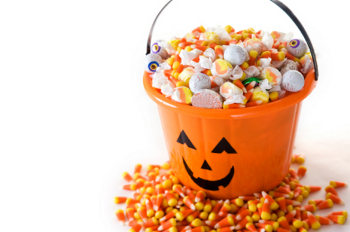This is guest post from Beth Kelly.
Individuals with diabetes must exercise caution on all major holidays, when an abundance of sugary treats and alcoholic beverages present constant waves of temptation. On no other night of the year is this more evident than on Halloween, a celebration traditionally centered on the consumption of candy.
While most trick-or-treaters go from house to house collecting goodies, diabetic children (and adults!) must watch their intake closely. But even so, diabetes doesn’t have to preclude enjoyment of the festivities as long as a few simple steps are taken. (These are, of course, in addition to the recommended safety precautions for everyone to follow).
 By preparing beforehand and indulging in moderation, it’s possible to enjoy tasty Halloween treats alongside friends and family. It’s safe for diabetics to eat some candy, but it’s important to keep the carbohydrate count in check — which can be tough to manage during all the excitement.
By preparing beforehand and indulging in moderation, it’s possible to enjoy tasty Halloween treats alongside friends and family. It’s safe for diabetics to eat some candy, but it’s important to keep the carbohydrate count in check — which can be tough to manage during all the excitement.
In consultation with your doctor, you can establish limits on how much candy can be consumed and how frequently it would be safe to do so. It may be possible to combine candy with extra insulin doses to allow the patient to have fun without sending his or her blood glucose levels skyrocketing. If you’re going to be handing out treats to the little ghouls who stop by your door, consider buying small inedible items (stickers, bouncy balls, glow sticks, etc) instead. If you’re working to manage your own diabetes, it won’t be a struggle to resist the urge to appropriate pieces from the stash, and every child can enjoy the hand out.
For parents, effective candy deployment strategies are crucial. If you’re the parent of a small child, try to organize the candy stash, and exchange less preferable sweets for something non-food related. Dole out favorite savory delights according to the schedule you’ve established in advance, and don’t leave the goodies lying around where they’ll pose a temptation to even the most strong-willed youngster.
For older children, one way of dealing with a large collection of accumulated sweets is by offering to “buy” them back, making the entire exercise a combination of a sweepstakes and a collectible trading game. Other rewards could include a day at the movies, a trip to the zoo or a new toy for trading in a large volume of candy. Whatever strategies you employ to deal with your Halloween candy situation, be sure to clearly communicate them with the other members of your household ahead of time. That way, there won’t be any confusion or accusations of unfairness when you enforce the candy rules.
Of course, there are plenty of ways to enjoy the festive spirit that have nothing to do with sugar-filled snacks. Haunted houses and hayrides, costume contests, and trips to the pumpkin patch are all creative alternatives that don’t put the focus on food. Scary movie marathons leading up to All Hallows Eve last all month long (DirecTV’s “Horrorfest” and Syfy’s “31 Days of Halloween Spook-a-Thon” are two to try), giving you plenty of opportunities to sit through all the Scream sequels you missed as a teenager.
Hosting a Halloween party is another great way to participate in diverting activities, such as fall-themed crafts and pumpkin carving, without having to cram down mindless sugars and carbs. Because you’ll be in charge of these events, you can arrange to have healthier foods present for the merrymakers to dine upon. Parties are a great way of passing a pleasant time with friends and family, and you can adjust the tone and ambiance of the event based upon the ages of the participants. Whether your guests are barely out of diapers or about to begin their retirements, a spooky-themed gathering is a good time for everyone.
Just as with other holidays throughout the year, Halloween is flexible enough to accommodate most of the challenges faced by diabetics. It might be the most candy-heavy day on the calendar, but you can make this night a treat without the sweets by including costumes, scary movies and jack-o-lanterns in the mix. Use your best judgment to find out what works for you and your loved ones and have a happy, safe, and healthy Halloween!
